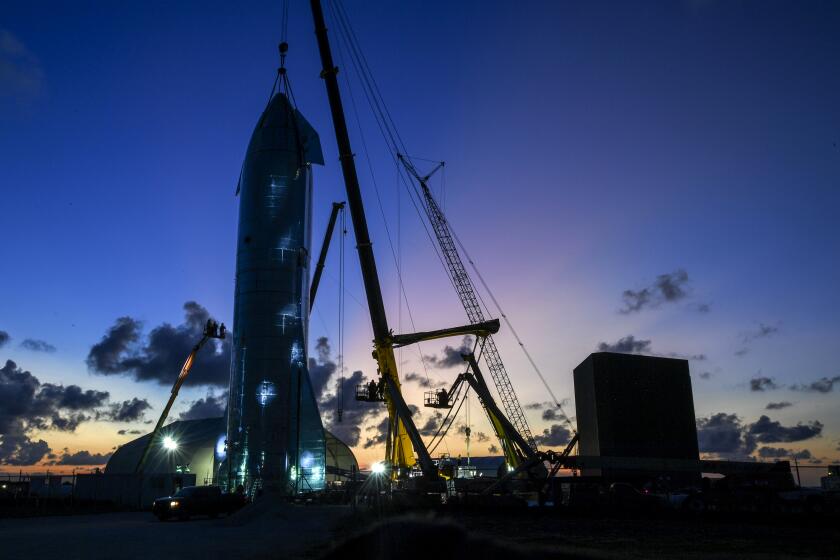SpaceX launches astronauts to the International Space Station

- Share via
SpaceX launched four astronauts to the International Space Station early Friday morning, marking the Elon Musk-led company’s second regular flight there with humans aboard.
The launch took place 5:49 a.m. Eastern time from Kennedy Space Center in Florida. The astronauts in the Crew Dragon capsule are expected to dock at the space station Saturday at 5:10 a.m. Eastern time.
NASA astronauts Shane Kimbrough and Megan McArthur, Japan Aerospace Exploration Agency astronaut Akihiko Hoshide and European Space Agency astronaut Thomas Pesquet are set to stay aboard the station for about six months.
For a few days, there’ll be something of a tight squeeze on the station, which typically contains six people. Currently it’s hosting seven, and the arrival of the astronauts who launched Friday will bring occupancy up to 11 until the capsule departs the station next week carrying some astronauts who have been up there since November.
Friday’s launch marked the first time NASA relied on a refurbished Crew Dragon capsule and a reused rocket booster to carry its astronauts.
The capsule, which previously carried NASA astronauts Bob Behnken and Doug Hurley to the space station during SpaceX’s first demonstration mission in May, went through a “multi-month” refurbishment process, Benji Reed, senior director of human spaceflight programs at SpaceX, told reporters in March. That included changing some valves and some parts of the spacecraft’s thermal protection system and strengthening the capsule’s structure so it can withstand stronger ocean waves upon splashdown, which would expand the acceptable weather limits for launch.
The proposed city of Starbase, Texas, would fit into a long tradition of communities dominated by a single employer
After the astronauts arrive at the space station, they’ll figure out where everyone will sleep. Eleven astronauts is a large contingent, but not the most ever — the space station has hosted as many as 13 astronauts, which last happened in 2010.
There are five sleep stations aboard the International Space Station, though astronauts can also sleep in the Crew Dragon capsule, the U.S. airlock or the Japanese segment of the station, a NASA official told reporters last month, describing it as a “campout” scenario. The astronauts will figure out the arrangements during the handoff period when the current crew briefs the newcomers, said Joel Montalbano, space station program manager at NASA.
Although it’s nice to have your own sleep station, camping out around the space station is doable, said Garrett Reisman, a former NASA astronaut who is now a USC professor of astronautical engineering and a senior advisor to SpaceX. In fact, he did it himself while he was in space.
Having 11 people aboard the station is “going to be a bit taxing on the crew, but we’re talking about a relatively short period of time,” he said.
From their living rooms and pickup trucks, amateur radio operators reach out to the International Space Station, circling 240 miles above Earth.
SpaceX’s crew launches to the space station are part of a NASA contract in which the U.S. space agency pays SpaceX and Boeing Co. to transport its astronauts to the station aboard company-owned and -operated craft. SpaceX first transported NASA astronauts to the station last May as part of a demonstration flight. The Hawthorne company’s craft was then certified for regular crew trips to the station.
Boeing launched its Starliner capsule on an uncrewed flight test in 2019, but because of software problems, the capsule never reached the space station and had to return to Earth early. The company plans to re-fly its uncrewed test before putting astronauts aboard the capsule, but NASA and Boeing have yet to announce a new target date.
More to Read
Inside the business of entertainment
The Wide Shot brings you news, analysis and insights on everything from streaming wars to production — and what it all means for the future.
You may occasionally receive promotional content from the Los Angeles Times.












